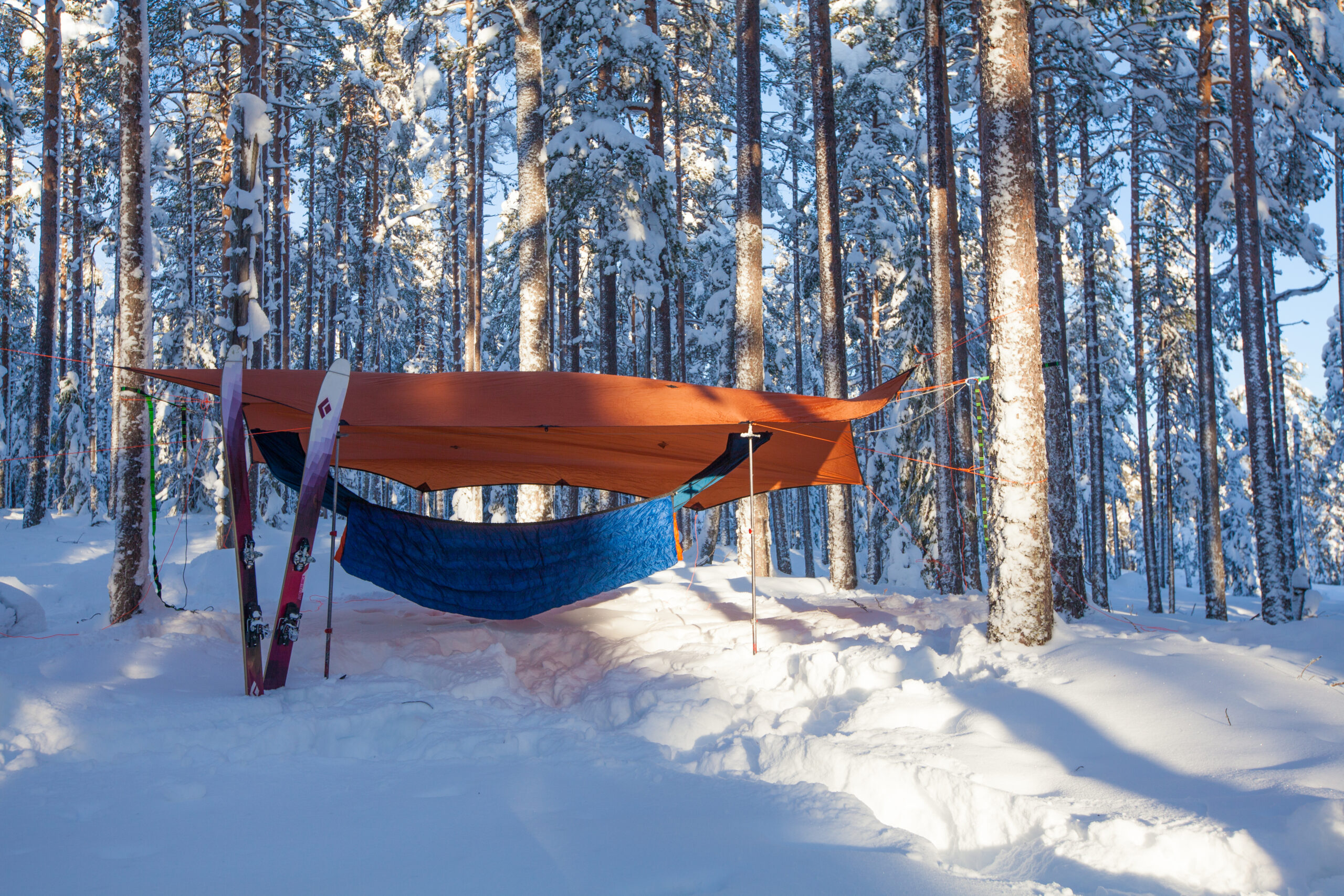How to Hammock Camp Comfortably in Cold, Wind, or Rain


Bad weather is a bad excuse to miss out on a perfectly good hammock camping opportunity! With the proper kit, a hammock and tarp setup can be at least as protective as a tent. Cold, wind, rain, or snow, all of it can be thwarted with the proper equipment and camp strategies. In this article, we’ll discuss tips and gear for fortifying your hammock camping shelter in cold weather, staying warm in a hammock, and hanging comfortably in nasty weather.
The right gear is critical, but your first line of defense against horrible conditions is always proper campsite selection. For starters, make sure to pick a site that is well protected by trees, foliage, and natural terrain features, rather than in an isolated grove or amongst dispersed trees. While optimal tarp configurations vary greatly depending upon the model of tarp and the weather it’s being pitched in; a few general rules can be applied in most scenarios. If you’re worried about gusts, try to avoid pitching your tarp perfectly parallel (to avoid it getting tugged upward) or perpendicular (to avoid it getting flattened) with the prevailing wind direction. When selecting trees to hang from, go out of your way to find sturdy trunks so as to avoid any chance of swaying disrupting your sleep. If facing a chilly night, avoid camping at the bottom of river valleys where cold damp air tends to coagulate.
But of course, just as important as choosing the right campsite and hammock pitch is choosing the right gear for the job. While we believe our hammocks are the very best on the market, hammocks themselves intrinsically offer little to no defense against the elements. What you surround yourself with could make or break the experience of hammock camping in cold weather.
Let’s start from the inside out, beginning with your quilt selection. When hammock camping in cold weather, it is imperative to stay warm in your hammock by utilizing a top quilt and underquilt system. The top quilt covers your torso, legs, and feet, while the underquilt insulates your backside from beneath and outside of the hammock. Conversely, a traditional sleeping bag will fail as your bodyweight compresses the loft underneath, leaving your back exposed to chill.
Buying your first hammock quilt setup? Check out our Economy Quilts. Looking to upgrade? Check out our Premium Quilts. At Hammock Gear, we pride ourselves on honest temperature ratings, but to be safe, we still encourage campers to pack quilts rated lower than the lowest temperatures they expect to encounter.
You can add additional protection against wind, condensation, rain splash, and morning dew with an Underquilt Protector! This ultralight softshell covering goes on the outside of your underquilt and acts as a breathable, weather resistant extra layer to defend those precious down plumes and help you stay warm in the hammock.
Unlike sleeping bags, hammock quilts eschew hoods. This saves the user weight and cost by allowing them to insulate their noggin with the hat and hood they were already bringing. However, in extreme cold situations, we recommend using a dedicated modular Down Hood. With this nifty piece of gear, you can effectively add a sleeping bag hood back into your quilt system, perfect for temps below 20F.
Now that you’ve established your cocoon of warmth, make sure to protect it against precipitation and wind with a proper tarp setup. While partial coverage tarps like the Quest Tarp save weight and work for most 3-season conditions, for truly foul weather, we recommend the full-coverage protection offered by the Journey Tarp or Palace Tarp. These shelters fully enclose your hammock on all sides, allowing it to hang as if situated in the middle of a very large tent, complete with front and rear entrances.
There are also plenty of ways to increase livability for extended bad weather camp outs by accessorizing. Add headroom to your tarp with Spreader Bars. These three ounce poles use tension to create extra interior volume along the sides of a tarp’s ridgeline, making it easier to stand upright in your shelter. Guarantee dry space beneath your hammock using a Dyneema Ground Cloth! While hammocks are highly functional above wet or muddy ground, it is much more pleasant to get in and out of them, or lay your gear out, when a dry surface is available below. If the weather you’re facing is inconsistent, consider a Tarp Sleeve! This handy mesh tube consolidates your tarp above you, allowing it to be re-pitched instantly at the first sign of rain, or rolled back up to embrace the blue skies ahead.
Never let bad weather keep you from hammock camping again! Whatever conditions you might be dealing with, we’ve got you covered with protective gear and accessories. Happy hanging!
Related Posts
The Best Camping Hammocks of 2024 – A Buyer’s Guide by Hammock Gear
A good camping hammock can completely transform how you experience…
Can Napping Hurt You? Unveiling the Pros & Cons of Daily Zzz’s
Napping, the act of taking a brief sleep during the…


